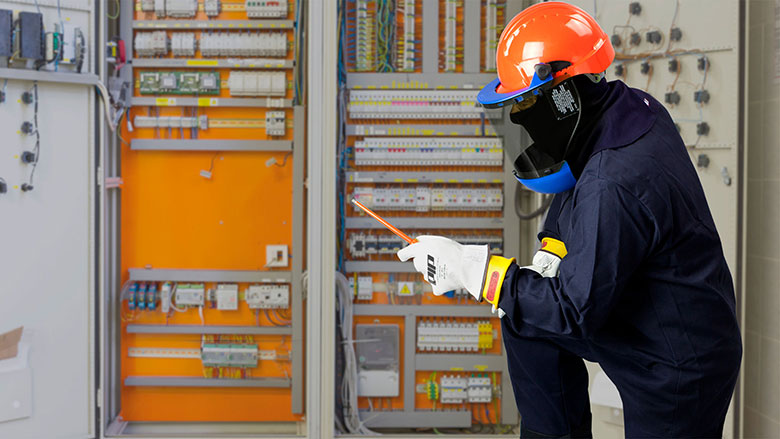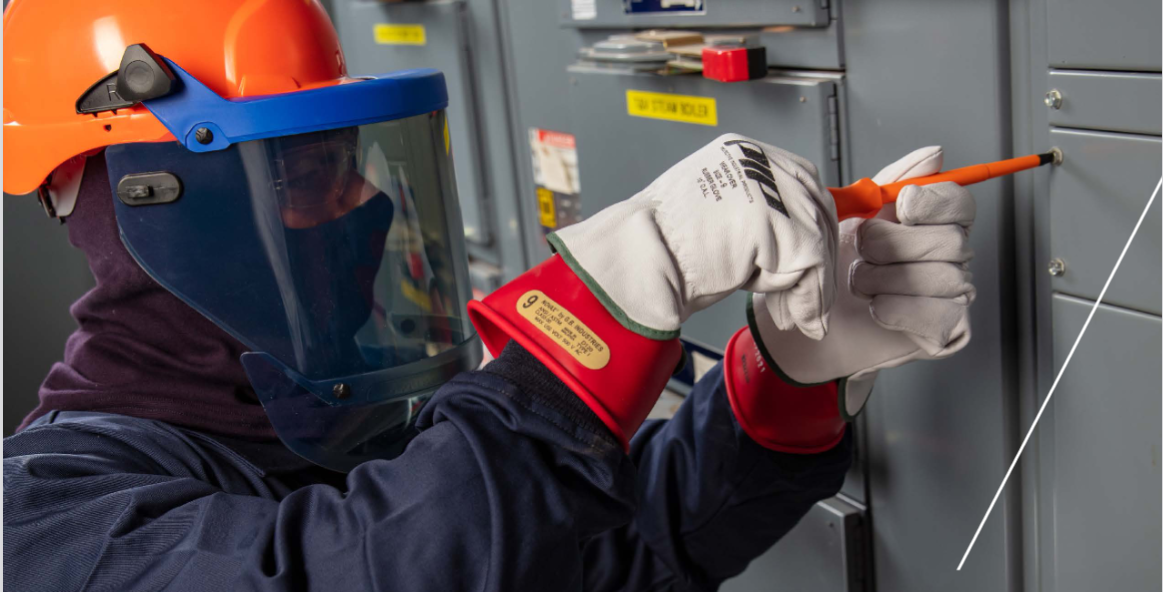UNDERSTANDING ELECTRICAL SAFETY P.P.E.
Selecting the proper P.P.E. for the job is an obvious first step to injury reduction but understanding the applications so the right safety products are used is critical when working with electricity.
→ Follow this link to skip blog and to +Shop for Arc & Flame Resistant P.P.E. Apparel now
Workers require flame resistant (FR) clothing to provide protection from the arc and flame hazards while on the job as well as comfort, regardless of body type and fit. Sometimes it’s a matter of personal preference, sometimes it’s a specific combination, and it’s typically determined by a hazard risk analysis done by your company.
Electricity is a serious workplace hazard that can result in serious injuries and even fatalities if workers are not properly equipped. Whether you are working with high voltage batteries, live wires, powerful electrical equipment or power transformers, MDS offers the right product designed specifically for protecting electrical a nd utility workers!
nd utility workers!
SPECIALIZED ELECTRICAL P.P.E
The dangers of being an electrician can vary with the type of work being performed but they’re on the front line of dangerous jobs.
At risk to occupational hazards such as electrical burns, electrical shock, lacerations, fire and arc-flash, it’s critical that electricians wear specialized protective gear such as sleeve protectors and specialized work gloves when installing, maintaining, and repairing electrical systems to maintain their personal safety.
The selection process can be confusing and to better help you in your selection, below is some information to help guide you along.
SELECTING THE PROPER PERSONAL PROTECTION
ARC FLASH 101
Simply put, an arc flash is a phenomenon where a flashover of electric current leaves its intended path and travels through the air from one conductor to another, or to ground. Only lasting for several milliseconds, when an arc fault occurs, it causes the release of massive amounts of energy into the air, resulting in explosions which can reach up to 35,000 degrees Fahrenheit in an instant.
With an arc burn, the electricity ionizes air particles and the heat that's produced can vaporize metal which means regular clothing doesn’t stand a chance. The intense light from an arc flash is accompanied by a pressure wave and sound blast loud enough to damage hearing or even brain function. This so called ‘arc blast’ also sends any loosen debris, tools or equipment flying out from the fault at supersonic speeds causing further injuries.
The results of ARC flash are often violent and when a human is in close proximity to the arc flash, serious injury and even death can occur. It’s not uncommon for an injured employee to never regain their past quality of life. Extended medical care is often required, sometimes costing in excess of $1,000,000.
ARC Flash Rated P.P.E.
ARC Rated P.P.E. helps to provide flame and thermal protection from exposure to an electrical ARC flash. AR garments are designed and treated to help limit exposure and burn percentage as a result of an electrical ARC flash incident. AR clothing is put through what's called a ASTM D6413 Vertical Flame Test that measures the resistance of garments. This test helps to determine if a garment or fabric will continue to burn after the source of combustion or ignition is removed from the situation by measuring how much of the fabric has been damaged by the flame. Those that pass are determined to meet the NFPA 70E Standard.
National Fire Protection Association (NFPA)
There are some variables to consider when selecting AR protective clothing. Most importantly, the employer must perform a Hazard Risk Analysis for the workplace to identify risks and set the appropriate boundaries which helps guide the employer to the level of protection needed.
The National Fire Protection Association (NFPA) uses four ARC flash P.P.E. categories to classify ranges of ARC flash hazards and the corresponding requirements for Personal Protective Equipment (P.P.E.). The categories are one method used in the current NFPA 70E standard to inform workers about the protection they need while working on energized equipment such as such as air conditioners, conveyor belts or light bulbs.
ARC Rating Value
Each category includes a minimum ARC Rating (AR) value for the required garment. This value indicated the amount of heat energy (in cal/cm²) that the clothing can absorb or block before the wearer would be likely to receive a second-degree burn. (Second-degree burns are expected when skin is exposed to 1.2 cal/cm² of incident energy).
The NFPA 70E-2018 PPE Categories are as follows:
- Category Class/PPE1 has a minimum ARC rating of 4 cal/cm²
- Category Class/PPE 2 has a minimum ARC rating of 8 cal/cm²
- Category Class/PPE 3 has a minimum ARC rating of 25 cal/cm²
- Category Class/PPE 4 has a minimum ARC rating of 40 cal/cm²
PPE Category 1 and 2 requirements are typically met with single-layer ARC/FR garments and lighter head and face gear. To meet higher risk hazard levels such as P.P.E. Category 3 or 4, multi-layer garments and headgear with more coverage is required.
4, multi-layer garments and headgear with more coverage is required.
FLAME RESISTANT (FR) 101
According to the Occupational Safety and Health Administration (OSHA), professionals should be equipped with flame resistant (FR) P.P.E. in situations where they're exposed to contact with energized circuit panels, electric arcs, molten metal or arcs from faulted conductors, and/or situations where heat energy estimates meet certain criteria.
The greatest benefit associated with FR clothing is that it will help to self-extinguish any sort of combustion immediately when it comes into contact with it, meaning that garments won't burn, drip, melt or ignite.
In addition to protection from combustion, flame resistant P.P.E. also provides enhanced insulation, meaning that even if a garment does combust for a brief period of time, the injury is likely to be minimal. Specifically, this insulation helps prevent the likelihood of severe second and third-degree burns.
Flame resistant garments earn their designation because they are made of fabrics that are inherently resistant to or are treated to be resistant to igniting when exposed directly to flame. The material resist ignition and/or will self-extinguish when ignited and will not melt. FR garments also create a thermal barrier to help protect the wearer’s skin when exposed to direct heat energy and may minimize the amount of second-and-third-degree burns incurred.
Flame Resistant (FR) Fabrics
Modacryloics, Aramids and Para-aramids are among the inherently fame-resistant fabrics. They do not lose those characteristics through wear or laundering. Treated fabrics such as cotton and cotton blends require FR treatment to achieve self-extinguishing properties. The treatment will eventually fade with washing. However, if the garment is properly cared for, the treatment can last the life of the garment. FR treated cotton and cotton blends provide a more comfortable and affordable solution.
*Keep this in mind – all AR garments are flame-resistant however not all FR garments are rated for ARC protection
DUAL CERTIFIED PROTECTION
Dual certified means that the materials have been tested and certified to meet both the NFPA 70E (ARC Flash Protection) and the NFPA 2112 (Flash Fire Protection) standards. The NFPA 2112-2012 requires third-party certification of the garment. Virtually all NFPA 2112-2012 certified garments are UL certified.
According to OSHA's General Duty Clause, it's the employer’s responsibility to assess workplace risk pertaining to fire or electric threats, estimate the potential arc hazards, and provide the proper P.P.E. Determining the proper P.P.E. is typically carried out via a hazard assessment, where employers assess workplace conditions in an effort to determine the likelihood of various threats.
INDUSTRIES THAT REQUIRE FLAME RESISTANT (FR) CLOTHING
Some industries that require FR and AR rated PPE include:
- Fire Fighting
- Oil and Gas
- Electrical Workers
- Construction
- Mining
- Metal Processing
- Production and Packaging of Chemicals, Plastics, Well Servicing, Fertilizers
It’s important to ensure that professionals are wearing the appropriate P.P.E. that will keep them safe and protected on a job site. MDS continues to add to our portfolio of top-rated, industry leading personal protection such as gloves, sleeves, coveralls, coats, vests, overalls, shirts and more.
Prevention is only a click away. All you need to do is tap the link and ....
+shop for Arc & Flame Resistant P.P.E. Apparel here now
Monday - Friday 8:30am - 4:30pm EST
Call or Click
•Questions. • Samples. •Special Requests. •Orders •Volume Discounts
Toll-Free +800-274-4637 | +716-668-4001 | [email protected] | MDSassociates.com
"We Want You To Return Home Safely...Every Day!™



